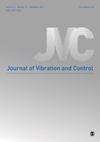Vertical vibration analysis of rolling interface based on dynamic rolling force with variable friction characteristics
IF 2.4
3区 工程技术
Q2 ACOUSTICS
引用次数: 0
Abstract
This study investigates the impact of variable friction characteristics at the rolling interface on the vertical vibration of plate and strip rolling mills. Based on the optimized Karman equilibrium theory, a dynamic rolling force model considering the front and back tension, elastic stretching, and rolling speed was established. The amplitude-frequency response equation of rolling mill system is solved by multi-scale method, and the influence of main parameters on vertical vibration of rolling mill system is analyzed. The results show that the increase of the first stiffness coefficient of dynamic rolling force leads to the decrease of the principal common amplitude of the system. On the contrary, when the third stiffness coefficient increases, the system exhibits a jump phenomenon. When the third stiffness coefficient of dynamic rolling force is reduced within a certain range, a stable and unique solution is obtained without jumping phenomenon. Moreover, the smaller the damping coefficient of the upper and lower roller system is, the larger the vibration amplitude is and the jump phenomenon occurs. Decreasing the external disturbance force can effectively reduce the system’s vertical vibration amplitude and suppress the resonance. In addition, with the change of external disturbance force, the roll system of the rolling mill shows a variety of complex motion states, such as periodic motion, double-periodic motion, and chaotic motion. The research results provide an effective theoretical reference for the suppression of vertical vibration of rolling mill.基于摩擦特性可变的动态滚动力的滚动界面垂直振动分析
本研究探讨了轧制界面摩擦特性的变化对板带轧机垂直振动的影响。基于优化的卡曼平衡理论,建立了考虑前后张力、弹性拉伸和轧制速度的动态轧制力模型。采用多尺度法求解了轧机系统的幅频响应方程,分析了主要参数对轧机系统垂直振动的影响。结果表明,动轧制力第一刚度系数的增加会导致系统主共振幅度的减小。相反,当第三刚度系数增大时,系统出现跳跃现象。当动态滚动力的第三刚度系数在一定范围内减小时,就会得到一个稳定的唯一解,而不会出现跳跃现象。此外,上下辊筒系统的阻尼系数越小,振动幅度越大,就会出现跳跃现象。减小外部干扰力可以有效减小系统的垂直振幅,抑制共振。此外,随着外部干扰力的变化,轧机辊子系统呈现出多种复杂的运动状态,如周期运动、双周期运动和混沌运动等。研究成果为抑制轧机垂直振动提供了有效的理论参考。
本文章由计算机程序翻译,如有差异,请以英文原文为准。
求助全文
约1分钟内获得全文
求助全文
来源期刊

Journal of Vibration and Control
工程技术-工程:机械
CiteScore
5.20
自引率
17.90%
发文量
336
审稿时长
6 months
期刊介绍:
The Journal of Vibration and Control is a peer-reviewed journal of analytical, computational and experimental studies of vibration phenomena and their control. The scope encompasses all linear and nonlinear vibration phenomena and covers topics such as: vibration and control of structures and machinery, signal analysis, aeroelasticity, neural networks, structural control and acoustics, noise and noise control, waves in solids and fluids and shock waves.
 求助内容:
求助内容: 应助结果提醒方式:
应助结果提醒方式:


